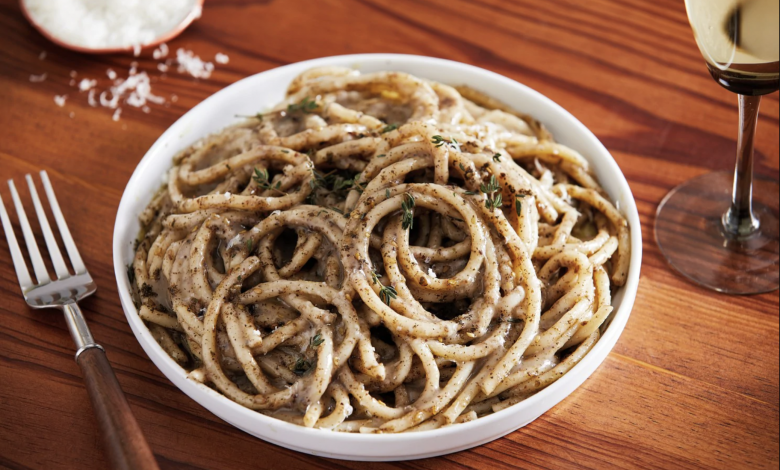
Ottolenghi’s cacio e pepe comes with a wonderful Middle Eastern twist
الطباخ أوتولينجي يقدم الباستا بالجبن والفلفل المشهورة بنكهة شرق أوسطية رائعة
By Joe Yonan | The Washington Post
Of all the Italian pasta dishes, few approach the perfection – and seeming simplicity – of cacio e pepe. Pasta noodles in a sauce of cheese (traditionally pecorino Romano) and cracked black pepper, the dish is sometimes called the Roman mac and cheese, but frankly that’s selling it short. The sharp cheese, the earthy pepper and perfectly cooked pasta combine to create something far more delicious than the sum of the dish’s parts.
There is absolutely nothing wrong with traditional cacio e pepe. Far from it. But – and you knew there’d be a “but,” didn’t you? – I did come across a recipe recently that makes one small addition to the classic, and it was such a beautiful complement that I knew I’d be making it this way for years to come.
It’s from the great and powerful Yotam Ottolenghi’s new book with Ixta Belfrage, “Ottolenghi Flavor.” The London-based chef has brought new awareness of Middle Eastern ingredients to countless readers with his previous bestsellers, including “Jerusalem,” “Ottolenghi,” “Plenty” and “Plenty More.” So it fits perfectly that he would try sprinkling one of his favorite spice blends – and as I’m a fellow Middle Easterner, one of mine – onto the Italian classic.
Za’atar is a blend of woodsy herbs such as thyme, marjoram, oregano and/or hyssop, sumac and sesame seeds that varies widely throughout the Middle East. As Ottolenghi writes, za’atar “doesn’t take anything away from the much-admired simplicity of the dish. All it does is add a layer of delicious herbiness that goes hand in hand with the pepper and the cheese.”
He and Belfrage have also perfected the techniques giving you a super-silky sauce that doesn’t separate – one of the risks when making cacio e pepe. They’re not the first to suggest that you cook the pasta in a much smaller-than-usual amount of water, then to use that super-starchy water to emulsify the sauce. But this was the first time I had tried it, and it worked wonderfully.
(Making sure you grate the cheeses very finely – I used a Microplane for that – and adding them in batches also helps.)
You purists, if you’re still reading at this point, might have noticed that I said “cheeses.” It’s true: Traditional, original Roman-style cacio e pepe depends on the use of just one cheese, pecorino Romano. Some recipes sneak in a little Parmesan, which makes perfect sense since some restaurants in Rome toss the pasta table-side in a hollowed-out wheel of Parmesan. Ottolenghi’s version flips the proportions of cheese, using four parts Parm and one part pecorino. You can feel free to flip it back or even to use all pecorino if you want.
But don’t get this twisted: Ottolenghi knows his stuff. His father is Italian, his name is Italian and, according to a 2009 article in Gourmet, “his grandmother re-created her own private Little Italy in her Tel Aviv suburb.” That’s all to say that when it comes to this staple of modern Roman cooking, as is the case with so many other dishes, the Ottolenghi way simply works.
Za’atar Cacio e Pepe
Active time: 15 minutes | Total time: 30 minutes
4 to 6 servings
Za’atar, the Middle Eastern spice blend, adds a layer of herbaceousness to the simple and classic Italian pasta of cheese and black pepper. To get the sauce super-smooth, grate the cheese as finely as possible (using a Microplane-style grater), and cook the pasta in a wide pan with much less water than usual. The latter technique packs the cooking water with starch, which is key to emulsifying the sauce.
INGREDIENTS
7 cups water
3/4 teaspoon fine sea salt, plus more for finishing
1 pound dried bucatini (or other long pasta, cooking time adjusted if necessary)
4 tablespoons unsalted butter
1 tablespoon plus 2 teaspoons za’atar, divided
2 teaspoons freshly cracked black pepper
4 ounces Parmesan cheese, very finely grated
1 ounce pecorino Romano cheese, very finely grated
2 teaspoons whole fresh marjoram or thyme leaves (optional)
DIRECTIONS
In a deep, wide skillet or Dutch oven over medium-high heat, bring the water to a boil, then stir in the salt. Add the bucatini and cook for 9 minutes (or per package instructions) until al dente, stirring every now and then so they don’t stick together or to the bottom of the pan, and to ensure they are submerged. Add hot water if necessary to keep the pasta covered. Drain, reserving all the cooking water. (You should have about 2 1/4 cups water; if not, add enough hot water until you do.)
In a large, high-sided, nonstick saute pan over high heat, cook the butter until bubbling, then stir in 1 tablespoon of the za’atar and the pepper and cook, stirring, until fragrant, about 1 minute.
Add the reserved cooking water, bring to a rapid boil and cook until silky and slightly reduced, about 5 minutes. Add the pasta and stir vigorously into the sauce. Add the Parmesan in two batches, continuing to stir vigorously as you go and waiting until the first half has melted before adding the next. Once all the Parmesan has melted, add the pecorino, continuing to stir, until it has also melted and the sauce is smooth and silky.
Transfer the pasta to a lipped platter and sprinkle with the marjoram or thyme (if using), remaining 2 teaspoons za’atar and a small pinch of salt. Serve hot.
Nutrition (based on 6 servings) | Calories: 387; Total Fat: 12g; Saturated Fat: 7g; Cholesterol: 28mg; Sodium: 547mg; Carbohydrates: 58g; Dietary Fiber: 3g; Sugar: 4g; Protein: 11g.
Adapted from “Ottolenghi Flavor” by Yotam Ottolenghi and Ixta Belfrage (Ten Speed Press, 2020).
بقلم جو يونان | واشنطن بوست – ترجمة WGOQatar
من بين جميع أطباق المعكرونة الإيطالية، القليل منها يقترب من الكمال – والبساطة الظاهرة – من الباستا بالجبن والفلفل، نودلز المعكرونة في صلصة الجبن، والفلفل الأسود المطحون، يُطلق على الطبق أحيانًا اسم المعكرونة بالجبن الروماني، لكن بصراحة هذا لا يوفيه حقه. يتحد الجبن ذو الطعمة اللاذعة والفلفل الطازج والمعكرونة المطبوخة بشكل مثالي لتكوين شيء أكثر لذة بكثير من مجموع أجزاء الطبق..
طبعاً، طبق الباستا بالجبن و الفلفل التقليدي لا خطأ فيه،لكن لقد عثرت على وصفة مؤخرًا تجعل إضافة صغيرة واحدة إلى الطبق الأساسي، وكانت إضافة لذيذة جداً لدرجة أنني عرفت أنني سأطهيها بهذه الطريقة باقي حياتي..
الطريقة أخذتها من كتاب يوتام أوتولينغي الجديد والرائع مع إكستا بيلفراج، “نكهة أوتولينغي “. جلب الشيف المقيم في لندن وعيًا جديدًا بمكونات الشرق الأوسط لعدد لا يحصى من القراء من خلال كتابه السابق الذي كان الأكثر مبيعًا بجانب كتبه السابقة، بما في ذلك “القدس” و “أوتولينغي” و “المزيد” و “أكثر من المزيد”. لذلك من المناسب تمامًا أنه سيحاول وضع إحدى خلطات التوابل المفضلة لديه على الكلاسيكية الإيطالية..
الزعتر هو مزيج من الأعشاب الخشبية مثل الزعتر والبردقوش والأوريجانو و / أو الزوفاء والسماق والسمسم التي تتنوع بشكل كبير في جميع أنحاء الشرق الأوسط. وكما كتب أوتولينغي، فإن الزعتر “لا يحور الطعم بعيدًا عن بساطة الطبق التي تحظى بإعجاب كبير. كل ما يفعله هو إضافة طبقة من الأعشاب اللذيذة جنبًا إلى جنب مع الفلفل والجبن”.
لقد أتقن أوتولينغي وبيلفراج أيضًا التقنيات التي تمنحك صلصة متجانسة لا تنفصل – أحد المخاطر عند صنع طبق الباستا بالجبن والفلفل. إنهم يقترحون عليك طهي المعكرونة بكمية أقل بكثير من المعتاد من الماء، ثم استخدام تلك المياه النشوية لطهي الصلصة. لكن هذه كانت المرة الأولى التي جربتها، ونجحت بشكل رائع.
(تأكد من بشر الأجبان جيداً.. ومن ثم اضافتها على دفعات)
أيها الأصوليون، إذا كنتم لا تزالون تقرأون في هذه المرحلة، فربما لاحظت أنني قلت “أجبان”. هذا صحيح: يعتمد طبق الباستا بالجبن والفلفل التقليدي على الطراز الروماني على استخدام نوع جبن واحد فقط، وهو جبن البيكورينو رومانو. وبعض الوصفات تضيف القليل من البارميزان، وهو أمر منطقي تمامًا لأن بعض المطاعم في روما تضع طبق الباستا الجانبي كحلقة مفرغة من جبن البارميزان لمعظم الكمية وربع جبن بوكورينو.. طبعاً تستطيع التبديل في الكميات.
لكن لا تظن للحظة أن أوتولينغي قد يخطئ في وصفاته. والده إيطالي، واسمه إيطالي، ووفقًا لمقال نُشر عام 2009 في جورميه، “أعادت جدته إنشاء إيطالي المصغرة الخاصة بها في ضاحية تل أبيب”. هذا كل ما يمكن قوله أنه عندما يتعلق الأمر بهذا العنصر الأساسي في الطبخ الروماني الحديث، كما هو الحال مع العديد من الأطباق الأخرى، فإن طريقة أوتولينغي ناجحة.
طبق الباستا بالجبن والفلفل والزعتر
الوقت التحضير: 15 دقيقة | الوقت الإجمالي: 30 دقيقة
4 إلى 6 حصص
الزعتر، مزيج التوابل الشرق أوسطي، يضيف طبقة من الأعشاب إلى المعكرونة الإيطالية البسيطة والكلاسيكية. وللحصول على صلصة متجانسة يجب بشر الجبنة جيدا. وطهي الباستا في طنجرة عريضة بماء اقل من المعتاد. بهذه الطريقة ماء الباستا يصبح مليئاً بالنشاء الباستا ويصبح مثالياً لوضعه مع الصلصة.
المكونات
7 أكواب ماء
ملعقة صغيرة من ملح البحر الناعم، بالإضافة إلى المزيد للنهاية3/4
1 رطل من البوكاتيني المجففة (أو غيرها من المعكرونة الطويلة، يتم تعديل وقت الطهي إذا لزم الأمر)
4 ملاعق كبيرة زبدة غير مملحة
1 ملعقة طعام بالإضافة إلى 2 ملعقة صغيرة زعتر مقسمة
2 ملاعق صغيرة من الفلفل الأسود الطازج
4 أونصات من جبنة البارميزان، مبشورة ناعماً
1 أونصة جبن بيكورينو رومانو، مبشور ناعماً جداً
ملعقتان صغيرتان من البردقوش الطازج أو أوراق الزعتر (اختياري)
طريقة التحضير
في مقلاة عميقة وواسعة على نار متوسطة، اترك الماء يغلي ثم أضف الملح. أضيف البوكاتيني واطهيه لمدة 9 دقائق (أو حسب تعليمات العبوة) حتى تمام النضج، مع التقليب بين الحين والآخر حتى لا يلتصقوا ببعضهم البعض أو في قاع المقلاة، وللتأكد من غمرهم في الماء. أضف الماء الساخن إذا لزم الأمر للحفاظ على تغطية المعكرونة. الحفاظ على مياه الطهي والاحتفاظ بها. (يجب أن يكون لديك حوالي كوبين وربع من الماء، وإذا لم يكن كذلك، أضف كمية كافية من الماء الساخن حتى يتم ذلك).
في مقلاة كبيرة عالية الجوانب مضادة للالتصاق على نار عالية، تُطهى الزبدة حتى تغلي، ثم تُقلب ملعقة كبيرة من الزعتر والفلفل ويُطهى مع التحريك حتى تفوح رائحته لمدة دقيقة تقريبًا.
يُضاف ماء طهي الباستا، ويُغلى المزيج سريعًا ويُطهى حتى يصبح حريريًا ويقل قليلاً، حوالي 5 دقائق. أضيفي المعكرونة وقلبي مع الصلصة. أضيفي جبن البارميزان على دفعتين، واستمري في التقليب وانتظري حتى يذوب النصف الأول قبل إضافة الثانية. بمجرد ذوبان كل جبن البارميزان، أضيفي جبن البيكورينو واستمري في التقليب حتى تذوب أيضًا وتصبح الصلصة ناعمة وحريرية.
انقلي المعكرونة إلى طبق عميق ورشي البردقوش أو الزعتر والملح (حسب الرغبة). يقدم ساخنا..
القيمة الغذائية (مقسمة ل 6 حصص) | السعرات الحرارية: 387 إجمالي الدهون: 12 جم؛ الدهون المشبعة: 7 جم؛ الكوليسترول: 28 ملغ؛ صوديوم: 547 ملغ؛ كربوهيدرات: 58 جم؛ الألياف الغذائية: 3 جم؛ السكر: 4 جم؛ البروتين: 11 جرام.
مقتبس من ” نكهة أوتولينغي” بواسطة يوتام أوتولينغي وليكسا بيلفراج.



